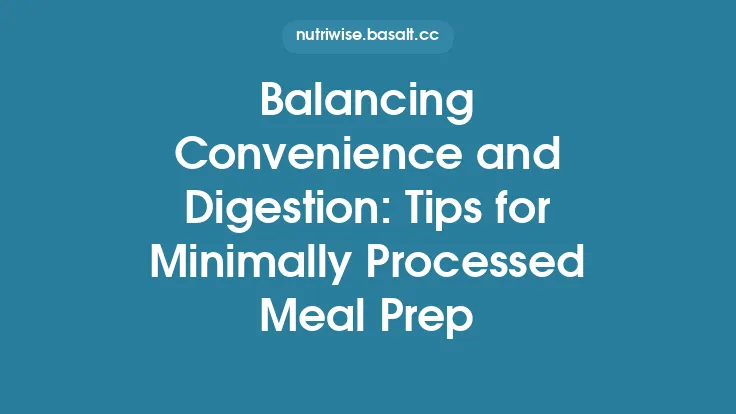Meal prepping is one of the most effective ways to keep both your wallet and your schedule in good shape. By taking a few strategic steps before the week really gets going, you can turn a chaotic scramble for dinner into a smooth, predictable routine that leaves you with more cash in your pocket and more minutes in your day. Below is a comprehensive guide to the hacks that make meal prep both money‑savvy and time‑efficient, without relying on bulk‑buying, seasonal shopping, or elaborate leftover strategies.
Create a Master Prep Blueprint
The foundation of any cost‑ and time‑saving meal‑prep system is a clear, visual plan. Think of it as a blueprint that tells you exactly what you’ll cook, when you’ll cook it, and how the pieces will fit together throughout the week.
- Map Out Your Weekly Meals
- Sketch a simple table with days of the week across the top and meal slots (breakfast, lunch, dinner, snacks) down the side.
- Fill in the slots with broad categories rather than specific recipes (e.g., “protein‑veggie‑grain bowl,” “quick stir‑fry,” “sheet‑pan dinner”). This flexibility lets you swap components without re‑doing the entire plan.
- Identify Overlap Opportunities
- Look for ingredients that can serve multiple meals. For instance, a batch of roasted carrots can appear in a grain bowl, a side dish, and a quick soup.
- By deliberately choosing overlapping components, you reduce the total number of unique items you need to purchase.
- Set a Prep Day and Time Block
- Choose a consistent day—often Sunday or a weekday evening—when you have a solid 60‑90‑minute window.
- Treat this block like an appointment; set a reminder and protect it from other obligations.
- Document the Blueprint
- Use a digital note‑taking app, a spreadsheet, or a printable planner. Having a permanent record makes it easy to replicate successful weeks and tweak less‑effective ones.
Streamline Your Shopping List with an “Ingredient Matrix”
A well‑structured shopping list prevents impulse buys and eliminates the need for multiple trips to the store, both of which drain money and time.
| Ingredient | Quantity Needed | Primary Meal(s) | Secondary Use |
|---|---|---|---|
| Brown rice | 2 cups (dry) | Grain bowls, stir‑fry | Breakfast porridge |
| Canned chickpeas | 2 cans | Salads, quick hummus | Soup thickener |
| Fresh spinach | 1 large bag | Salads, sautéed side | Smoothie base |
| Pre‑cut bell peppers | 1 pack | Sheet‑pan dinner, stir‑fry | Snack sticks |
| Olive oil | 1 bottle (small) | Roasting, sautéing | Dressing base |
How to Build the Matrix
- Pull from Your Blueprint – List every ingredient required for each meal component.
- Consolidate Duplicates – If two meals call for “1 cup of quinoa,” combine them into a single entry.
- Add a “Secondary Use” Column – This prompts you to think of additional ways to incorporate each item, maximizing its value without creating “leftovers” in the traditional sense.
- Set Quantity Thresholds – Use the smallest practical packaging size that meets your total need. This avoids over‑purchasing while still giving you enough for the week.
The matrix becomes a living document; after each week, you can adjust quantities based on what actually got used, refining both cost and waste.
Optimize Kitchen Workflow with Mise en Place
“Mise en place” (French for “everything in its place”) is a professional kitchen principle that translates perfectly to home meal prep.
- Gather All Tools First
- Lay out cutting boards, knives, measuring cups, pans, and storage containers before you start. This prevents frantic searches mid‑prep.
- Pre‑Measure Dry Ingredients
- Portion out rice, lentils, spices, and sauces into small bowls or silicone cups. When the cooking step arrives, you can dump the measured amount directly into the pan.
- Batch‑Prep Produce
- Wash, dry, and trim all vegetables at once. Use a mandoline or food processor to slice everything uniformly, which speeds up cooking and ensures even texture.
- Label as You Go
- As soon as a component is cooked and cooled, place it in a labeled container (e.g., “Quinoa – 2 cups – 4/12”). This eliminates the need for guesswork later and reduces the time spent searching the fridge.
By front‑loading organization, you shave minutes off each cooking step and avoid the hidden cost of wasted ingredients that sit forgotten.
Leverage Multi‑Purpose Ingredients for Versatile Meals
Choosing ingredients that can be transformed in multiple ways is a powerful hack that reduces both grocery spend and prep time.
| Ingredient | Primary Prep | Alternate Transformations |
|---|---|---|
| Rotisserie chicken (store‑bought) | Shred for bowls | Toss into salads, blend for quick soup |
| Canned tomatoes | Base for sauce | Add to stews, mix into grain salads |
| Greek yogurt (plain) | Breakfast parfait | Use as a creamy sauce, substitute for mayo |
| Frozen mixed vegetables | Quick stir‑fry | Blend into smoothies, add to omelets |
| Pre‑cooked quinoa | Grain bowl base | Use in stuffed peppers, make breakfast porridge |
Implementation Tips
- Cook Once, Use Twice – For example, roast a tray of mixed vegetables and keep half for the week’s dinners while the other half becomes a quick side for lunch.
- Flavor Shifts – A single ingredient can feel entirely new with a different seasoning profile. Swap a Mexican spice blend for an Italian herb mix, and the same chicken or beans become a different dish.
- Texture Play – Blend cooked cauliflower into a creamy sauce, or mash sweet potatoes for a quick mash topping. Changing texture adds variety without new purchases.
Time‑Saving Cooking Techniques That Cut Both Clock and Cost
Certain cooking methods are inherently efficient because they require minimal supervision, use fewer pots, and often make the most of inexpensive ingredients.
- Sheet‑Pan Cooking
- Spread protein, vegetables, and a starch (e.g., cubed potatoes) on a single parchment‑lined tray. Drizzle with oil and season, then roast. One pan means one cleanup, and the oven does the work while you attend to other tasks.
- One‑Pot Meals
- Combine grains, legumes, aromatics, and seasonings in a single pot or Dutch oven. As the liquid simmers, everything cooks together, infusing flavors and eliminating the need for separate cooking vessels.
- Stir‑Fry with Pre‑Cut Veggies
- High heat, short cooking time. Using pre‑cut or frozen vegetables reduces prep time dramatically. A quick toss with a pre‑measured sauce yields a complete meal in under 10 minutes.
- Microwave Steaming
- Place chopped vegetables in a microwave‑safe bowl with a splash of water, cover, and steam in 2–4 minutes. This method preserves nutrients and requires no stovetop energy.
- Pressure Cooking (Instant Pot/Pressure Cooker)
- Cook beans, grains, or tougher cuts of meat in a fraction of the usual time. The sealed environment also reduces water usage, which can translate into lower utility costs.
Each technique emphasizes “set it and forget it,” freeing you to multitask or simply relax while the food cooks.
Smart Storage Solutions to Extend Freshness and Reduce Waste
Even the most efficient prep can be undone by spoilage. Proper storage maximizes the lifespan of your ingredients, protecting both your time and money.
- Portion‑Sized Containers
- Use 1‑cup or 2‑cup containers for individual servings. This prevents you from having to re‑portion at mealtime, and you can grab a ready‑made portion without rummaging.
- Vacuum‑Seal for Long‑Term Freezing
- A handheld vacuum sealer removes air, dramatically slowing freezer burn. It’s especially useful for cooked grains, soups, and sauces that you’ll store for several weeks.
- Label with Date and Use‑By
- A simple marker pen on the lid tells you exactly when the item was prepared. Rotate older items to the front of the fridge or freezer to ensure they’re used first.
- Transparent Bins for Visibility
- Clear containers let you see at a glance what’s inside, reducing the “I forgot I have this” moments that lead to duplicate purchases.
- Temperature Zones
- Store items that need quick access (e.g., pre‑cooked proteins) at eye level, while less‑frequent items (e.g., bulk spices) can go on higher shelves. This organization speeds up meal assembly.
Harness Kitchen Gadgets for Efficiency Without Bulk Buying
Investing in a few versatile tools can shave minutes off prep and cooking, and they often pay for themselves through reduced waste.
| Gadget | Primary Function | How It Saves Money & Time |
|---|---|---|
| Food processor | Chops, shreds, purees | Replaces manual chopping, speeds up sauce making |
| Immersion blender | Blends soups, sauces directly in pot | Eliminates transfer to a separate blender, reduces cleanup |
| Silicone muffin trays | Portion‑size freezer packs | Creates uniform servings that thaw quickly |
| Digital kitchen scale | Precise portioning | Prevents over‑purchasing by measuring exact amounts |
| Reusable silicone bags | Store marinated proteins, frozen veggies | Cuts down on disposable zip‑top bags, keeps flavors sealed |
When selecting gadgets, prioritize those that perform multiple tasks (e.g., a food processor that also makes dough). This avoids clutter and ensures each purchase adds genuine value to your prep workflow.
Build Modular Meal Components for Quick Assembly
Think of each meal as a combination of three interchangeable modules: Protein, Vegetable, and Base. By preparing each module in a neutral style, you can mix and match throughout the week.
- Protein Module
- Cook a batch of plain grilled chicken breast, a pot of seasoned lentils, and a pan‑seared tofu block. Keep them unseasoned or lightly seasoned so they can adapt to different flavor profiles.
- Vegetable Module
- Roast a mixed tray of carrots, broccoli, and zucchini with just olive oil and salt. Store the roasted veggies separately from any sauces.
- Base Module
- Prepare a neutral grain such as quinoa, brown rice, or couscous. Keep it plain, then season per meal (e.g., add soy sauce for an Asian bowl, or lemon zest for a Mediterranean twist).
Assembly Example
- Mexican‑style bowl: Base + protein (lentils) + veggies + salsa + avocado.
- Mediterranean plate: Base + protein (grilled chicken) + veggies + tzatziki + olives.
- Asian stir‑fry: Base + protein (tofu) + veggies + soy‑ginger glaze.
Because each component is ready to go, assembling a meal takes under five minutes—no cooking, just plating.
Schedule Your Prep Sessions for Maximum Productivity
Even with a solid plan, the timing of your prep work determines how smoothly the week runs.
| Day | Task | Approx. Time |
|---|---|---|
| Sunday (or chosen prep day) | Review blueprint, finalize shopping list | 10 min |
| Same day | Grocery run (using ingredient matrix) | 30–45 min |
| Sunday evening | Wash & dry produce, pre‑measure dry goods | 15 min |
| Sunday night | Cook protein, base, and vegetable modules | 45–60 min |
| Monday morning | Portion and label containers for the first three days | 10 min |
| Mid‑week (Wednesday) | Quick “top‑up” session: reheat, add fresh garnish, or prep a new protein if needed | 15 min |
By front‑loading the bulk of the work and leaving a short mid‑week touch‑up, you avoid the dreaded “I have nothing to eat” scramble while keeping the overall time commitment low.
Track Your Savings and Time Gains
The final piece of the puzzle is measurement. Knowing how much you’ve saved reinforces the habit and highlights areas for improvement.
- Create a Simple Spreadsheet
- Columns: *Week, Total Grocery Spend, Estimated Prep Time (hrs)*, *Meals Completed, Food Waste (lbs/servings)*.
- Update it weekly; over a month you’ll see trends.
- Calculate Cost per Meal
- Divide total spend by the number of meals you actually ate. A well‑executed prep system often brings this figure below $2–$3 per serving.
- Time‑Saved Valuation
- Assign a monetary value to your saved time (e.g., $15/hr). Multiply by the hours shaved off cooking during the week. This “time credit” can be added to your cost‑per‑meal calculation for a fuller picture of the benefit.
- Adjust Based on Data
- If waste spikes, revisit your ingredient matrix. If prep time creeps up, consider swapping a gadget or simplifying a module.
Regular tracking turns an intuitive practice into a data‑driven strategy, ensuring that your meal‑prep hacks continue to deliver both financial and temporal returns.
By integrating these hacks—structured planning, smart ingredient selection, efficient cooking methods, purposeful storage, and ongoing measurement—you’ll build a meal‑prep system that consistently saves money and frees up valuable time. The result is not just a cleaner fridge and a healthier wallet, but also the peace of mind that comes from knowing dinner (and lunch, and snacks) are already taken care of, leaving you free to focus on the things that truly matter.





